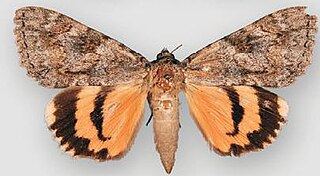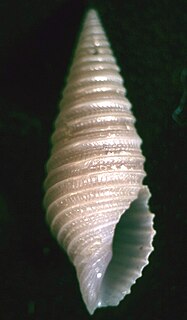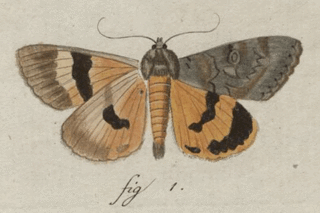
Catocala is a generally Holarctic genus of moths in the family Erebidae. The genus was erected by Carl Linnaeus in his 1767 12th edition of Systema Naturae. The moths are commonly known as underwing moths or simply underwings. These terms are sometimes used for a few related moths, but usually – especially when used in plural, not as part of a species name – they are used to refer to Catocala only.

Catocala electa, the rosy underwing, is a moth of the family Erebidae. The species was first described by Karl Friedrich Vieweg in 1790. It can be found in Europe and Asia.

Hadennia is a genus of moths of the family Erebidae. The genus was described by Moore in 1885.

Paracolax is a genus of litter moths of the family Erebidae. The genus was erected by Jacob Hübner in 1825.
Sinarella is a genus of moths of the family Erebidae. The genus was erected by Felix Bryk in 1949.

Catocala jessica, the Jessica underwing, is a moth of the family Erebidae. The species was first described by Henry Edwards in 1877. It was described in the United States from Arizona through Colorado to Illinois and California.

Catocala sordida, the sordid underwing, is a moth of the family Erebidae. The species was first described by Augustus Radcliffe Grote in 1877. It is found in North America from Saskatchewan east to New Brunswick and Prince Edward Island and south through Maine and Connecticut to Florida, west to Texas and north to Manitoba.
Catocala bella is a moth of the family Erebidae first described by Arthur Gardiner Butler in 1877. It is found in Russia, Korea, China and Japan.

Catocala dejeani is a moth of the family Erebidae first described by Rudolf Mell in 1936. It is found in China and Taiwan.

Tomopleura is a genus of sea snails, marine gastropod mollusks in the family Borsoniidae.

Eterusia aedea, the red slug caterpillar, is a species of moth in the family Zygaenidae. It was described by Carl Linnaeus in his 1763 Centuria Insectorum. It is found in Sri Lanka, India, Nepal, Taiwan, Japan and China.
Hanzawa Naoki (半沢直樹) is a 2013 and 2020 Japanese television series by Japanese broadcaster TBS based on the Hanzawa Naoki series (半沢直樹シリーズ) of novels by Jun Ikeido (池井戸潤). It follows the story of Hanzawa Naoki, a banker working for the largest bank in Japan, Tokyo Chuo Bank. He faces numerous obstacles from upper management as he climbs his way up the ranks. The show received consistently high ratings: the final episode of Season 1 reached 42.2% in the Kanto area, the highest figure for a drama in the Heisei Era.
Catocala ella is a moth in the family Erebidae first described by Arthur Gardiner Butler in 1877. It is found in south-eastern Siberia and Japan.
Catocala jonasii is a moth in the family Erebidae first described by Arthur Gardiner Butler in 1877. It is found in Japan.
Catocala mirifica is a moth in the family Erebidae first described by Arthur Gardiner Butler in 1877. It is found in Japan.

Catocala neonympha is a moth in the family Erebidae first described by Arthur Gardiner Butler in 1877. It is found in south-western Russia, Ukraine, Kazakhstan, eastern Turkey, Iraq, Armenia, Kurdistan, Afghanistan, the Altai Mountains and southern Siberia.
Catocala praegnax is a moth in the family Erebidae first described by Francis Walker in 1858. It is found in Japan, northern China and Taiwan.










